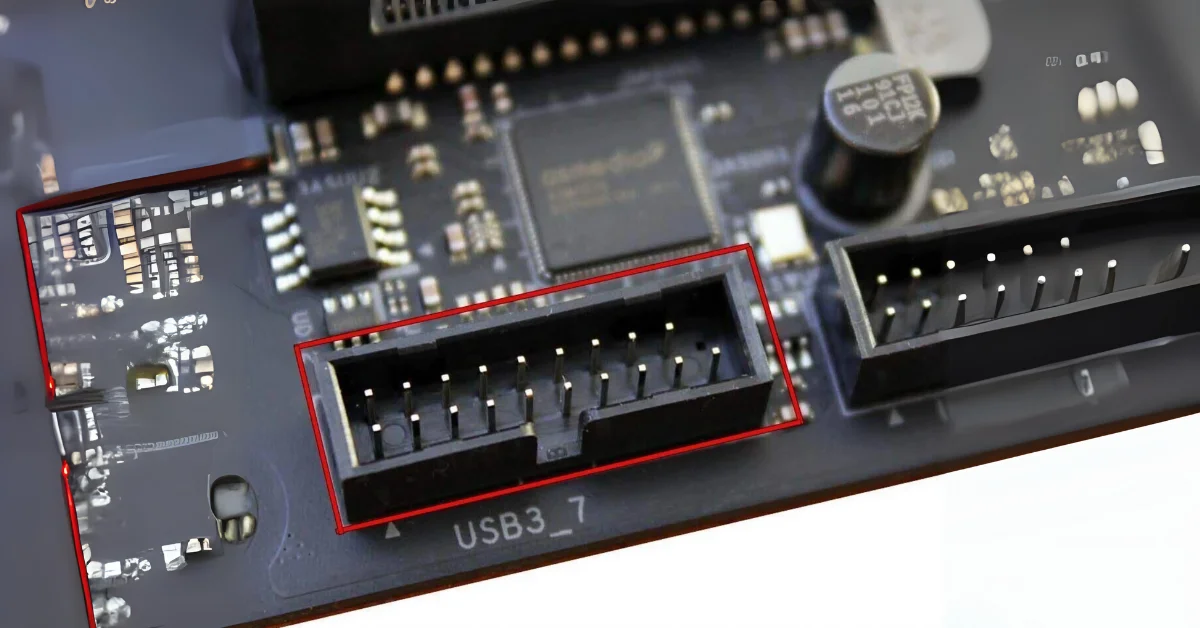In this article, we will take a look at USB headers and what they are used for. USB headers are motherboard connectors that allow you to connect extra USB ports to your computer. They can be very useful if you have a lot of USB devices that you need to connect to your computer or if you want to add more USB ports for future expansion.
But things are not that simple – there are actually many different kinds of USB headers with different speed capabilities. So let’s take a look at the different types of USB headers and see their differences.
Different USB Versions

As I told you, USB versions are a bit complicated, but I will take a chronological approach to try and make things as simple as possible.
There are 8 different types of USB versions, so let’s take a look at each one based on the release year:
2000
In the year 2000, things were pretty simple, and only one type of USB version was released, the USB 2.0.
The USB 2.0 version is still used today and is a very common type of USB. It supports data transfer speeds of up to 480Mbps (0.48 Gbps).
2008
In 2008, things continued to be pretty simple, with only one type of USB version being released – the USB 3.0.
The USB 3.0 was a big update from the USB 2.0 as it supports data transfer speeds of up to 5Gbps (5120Mbps).
2013
In 2013, things got a bit more complicated with the release of two different USB versions – the USB 3.1 Gen 1 and the USB 3.1 Gen 2.
The USB 3.1 Gen 1 is actually the same as the USB 3.0 and supports data transfer speeds of up to 5Gbps (5120Mbps).
The USB 3.1 Gen 2 is the updated version of the USB 3.1 Gen 1 and supports data transfer speeds of up to 10Gbps (10240Mbps).
2017
The year 2017 was the year that things got really complicated with the release of 4 different types of USB versions – the USB 3.2 Gen 1×1, the USB 3.2 Gen 1×2, the USB 3.2 Gen 2×1, and the USB 3.2 Gen 2×2.
Similarities And Differences Between The Different USB Versions
The USB 3.2 Gen 1×1 header is actually the same as the USB 3.0 and USB 3.1 Gen and supports data transfer speeds of up to 5G
The USB 3.2 Gen 1×2 header is a dual-lane version of the USB 3.2 Gen 1×1 header and supports data transfer speeds of up to 10Gbps (10240Mbps).
The USB 3.2 Gen 2×1 header uses the same transfer mode as the USB 3.1 Gen 2 header and supports data transfer speeds of up to 10Gbps (10240Mbps).
The USB 3.2 Gen 2×2 header is a dual-lane version of the USB 3.2 Gen 2×1 header and supports data transfer speeds of up to 20Gbps (20480Mbps).
As you see, things are getting really complicated with all these different types of USB headers. But don’t worry, it is pretty normal; I also created a table with all the different types of USB versions and their capabilities, so you can use it as a reference.
| Version | Speed (Gbps) | Mode | Options (Interface) |
|---|---|---|---|
| USB 2.0 | 0.48 | HighSpeed | Type-A |
| USB 3.0 | 5.0 | SuperSpeed | Type-A |
| USB 3.1 Gen 1 | 5.0 | SuperSpeed | Type-A / Type-C |
| USB 3.1 Gen 1×1 | 5.0 | SuperSpeed | Type-A / Type-C |
| USB 3.2 Gen 1×1 | 5.0 | SuperSpeed | Type-A / Type-C |
| USB 3.2 Gen 1×2 (Dual-Channel) | 10.0 | SuperSpeed | Type-C |
| USB 3.1 Gen 2 | 10.0 | SuperSpeed+ | Type-A / Type-C |
| USB 3.2 Gen 2×1 | 10.0 | SuperSpeed+ | Type-A / Type-C |
| USB 3.2 Gen 2×2 (Dual-Channel) | 20.0 | SuperSpeed++ | Type-C |
And to make things even more complicated, in the next section, I will talk about the different types of USB headers, but first, let’s clarify what a USB header is.
Related Articles: How To Connect Extra Fans To Motherboard
What is a USB header?
A USB header is a small electrical connector that is used to connect USB ports to the motherboard. The USB header is located on the motherboard and provides a USB signal for the USB ports connected to it via a short cable.
So if you want to make the USB ports of your PC case functional this is where you need to connect the front-panel USB cables.
Related Articles: What Are Front Panel Connectors?
Different Types Of USB Headers
I have already talked about the different types of USB versions, but in this section, I am going to talk about the different types of USB headers.
There are four different types of USB headers – the USB 2.0 header, the USB 3.0 header, the USB 3.1 Gen 2 header, and the USB 3.2Gen 2×2 header.
Now everything starts to make more sense cause if you check the above table, you will notice that each USB header type corresponds to a specific USB mode (HighSpeed, SuperSpeed, etc.).
So let’s talk about these headers and see what USB versions you should use with each one.
USB 2.0 Header
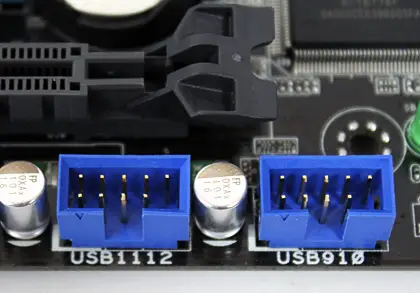
The USB 2.0 header is very easy to spot; it is a 9-pin connector in a two-row arrangement. As you can understand, this header is used to connect the USB 2.0 (HighSpeed) ports to the motherboard.
Finally, if you want to know what a USB 2.0 header cable looks like, take a look at the picture below.
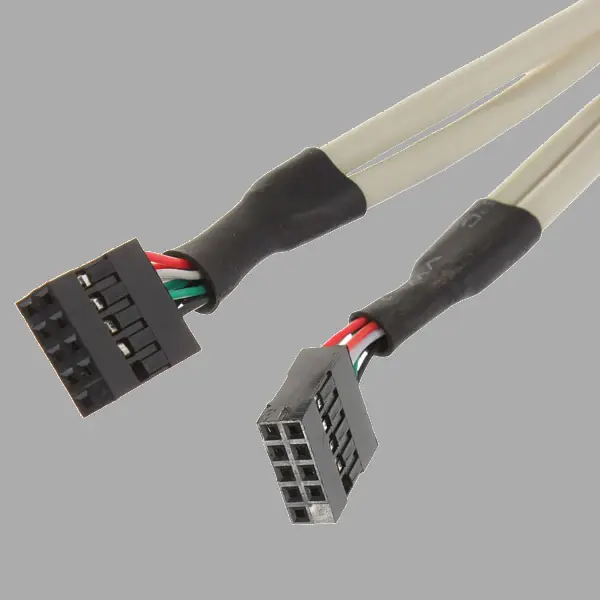
USB 3.0 Header
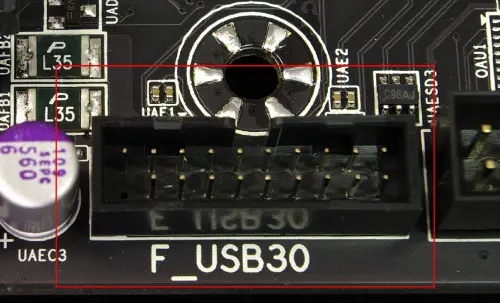
The USB 3.0 header is also easy to spot; it is a 19-pin connector in a two-row arrangement. As you can understand, this header is used to connect the USB 3.0 ports to the motherboard.
The USB 3.0 is used to connect not only the USB 3.0 ports but also the USB 3.1 Gen 1 ports and the USB Gen 3.2 Gen 1 ports. For this reason, it gets labeled with different names like USB 3.0 header, USB 3.1 Gen 1 header, or USB 3.2 Gen 1 header.
The header’s name depends on the year your motherboard was released. If it is an older motherboard, it will have the USB 3.0 header label, and if it is a newer motherboard, it will have the USB 3.2 Gen 1 header label.
If you didn’t get it, all the “Superspeed” transfer mode ports use this header.
Take a look at the picture below to see an example of a USB 3.0 header cable.
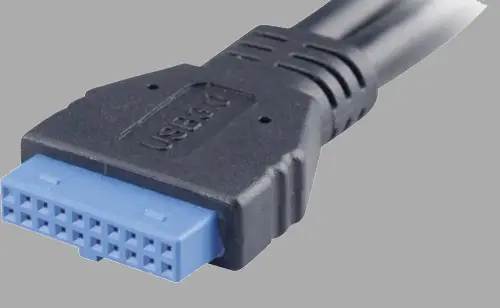
USB 3.1 Gen 2 Header
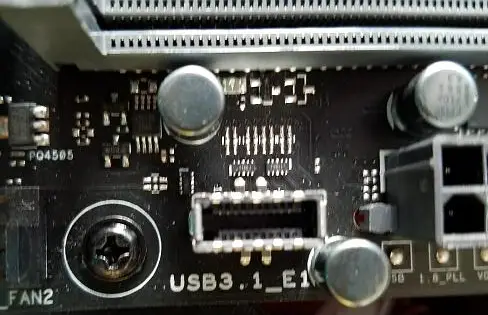
The USB 3.1 Gen 2 header is completely different from the previous headers and doesn’t have pins at all. It is a small rectangular connector that uses the USB 3.1 Gen 2 transfer mode.
This header is used by the “Superspeed+” transfer mode ports, which are the USB 3.1 Gen 2 and the USB 3.2 Gen 2 x1 ports. So if you have a newer motherboard, don’t get surprised if you see it labeled as a USB 3.2 Gen 2 header.
The cable for this header looks like the one in the picture below.

USB 3.2 Gen 2×2 Header

The USB 3.2 Gen 2×2 header is a dual-lane version of the USB 3.2 Gen 2×1 header and uses the USB 3.2 Gen 2 transfer mode.
This is the fastest and latest header, and it is used by the “Superspeed++” transfer mode ports, which are only the USB 3.2 Gen 2 x2 ports.
Most average motherboards don’t have this header, and only high-end motherboards have it.
So these are all the different types of USB headers. As you can see, they are all pretty easy to spot, and you just need to match the header with the ports that you want to use.
How to spot The USB headers on your motherboard?
Now that you know about the different types of USB versions and the USB headers, I am going to show you how to spot the USB headers on your motherboard.
There are two ways to do this, the first way is by looking at the motherboard manual, and the second way is by looking at your motherboard.
Motherboard Manual

This way is pretty self-explanatory, and I will not go into too much detail.
All you need to do is open the motherboard manual and look for the section that has a diagram of the motherboard. Look for the USB headers and then match the header with the ports that you want to use.
Related Article: Sys Fan vs CPU Fan: ALL The Differences
Physically looking at your Motherboard
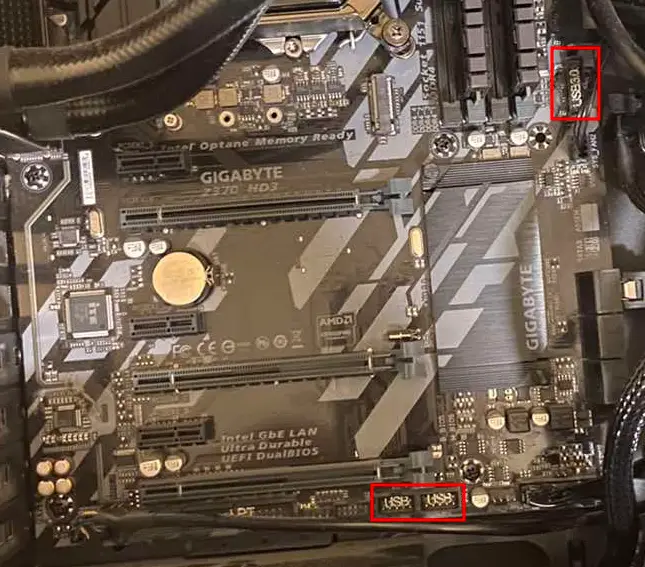
This is a bit more tricky, but not that hard either.
Just take a look at your motherboard and look for the appropriately labeled header. The labeling will vary depending on the header type and the motherboard you have, but it will include the word “USB” and the version of it.
USB Headers FAQ
What Is The Function Of A USB Header?
The USB header is used to connect the USB ports to the motherboard. Your PC case will have some USB ports on it, and you will need to connect them to the motherboard to use them.
What Is A USB 3 Header?
A USB3 header is a USB header that uses the USB3 transfer mode. It is used to connect all the USB3 ports to the motherboard.
How Many USB Ports Are In A Header?
Depending on the header version, a header has either two or three USB ports.
The USB 2.0 and the USB 3.0 headers support two USB ports, and the USB 3.1 Gen 2 and the USB 3.2 Gen 2×2 headers support one USB port.
Does My Motherboard Have A USB Header?
Yes, all motherboards have USB headers. However, not all motherboards have the same type of USB header. So you need to check the number and type of the USB headers of your motherboard and compare it to the ports that you want to use.
What Is The USB 3.2 Gen 2×1 Header?
The USB 3.2 Gen 2×1 header is a USB header that uses the USB 3.2 Gen 2 transfer mode and has one channel. It is used to connect the USB 3.2 Gen 2 x1 ports to the motherboard.
How Many USB Headers Do Motherboards Have?
Most motherboards have at least two USB headers, but some high-end motherboards can have many more. The number and type of USB headers will vary depending on the motherboard.
Conclusion
I hope I have covered everything that you need to know about USB header connectors. I have talked about the different USB versions, the different types of USB headers, and how to spot the USB headers on your motherboard. If you have any questions or if I missed something, please let me know in the comments below. Thanks for reading!

